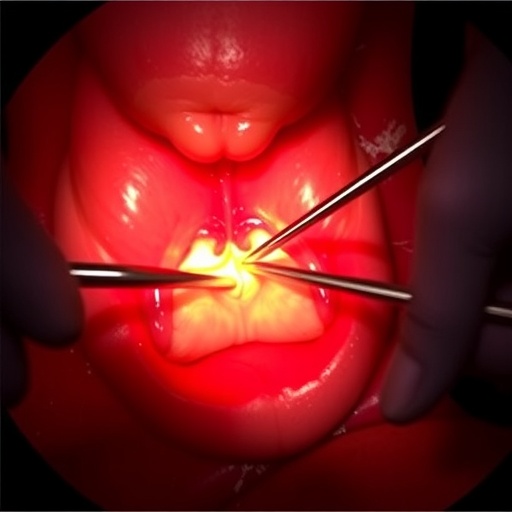
In a groundbreaking study published in the Journal of Ovarian Research, researchers have identified high-grade serous ovarian cancer (HGSOC) stem cell-based subtypes using innovative prognostic models. The authors, Wu et al., have significantly advanced our understanding of how these subtypes can influence treatment responses and patient outcomes. This research sheds light on the complex interplay between cancer stem cells and the tumor microenvironment, particularly focusing on the cellular markers, VSIG4 and STAB1, which are highly expressed in macrophages associated with this aggressive form of cancer.
High-grade serous ovarian cancer remains one of the deadliest gynecological malignancies, often diagnosed at an advanced stage due to the subtlety of early symptoms. The late diagnosis correlates with poor prognosis, emphasizing the need for precise models that can refine therapeutic strategies. Researchers have now employed advanced bioinformatics to classify the cancer stem cell subtypes, which could ultimately reshape treatment protocols and clinical outcomes for patients. By dissecting the molecular underpinnings of these subtypes, this research holds promise for identifying biomarkers that can guide personalized treatment plans.
One of the key findings of this research is the identification of two important markers: VSIG4 and STAB1. Both of these proteins, found predominantly in macrophages in the tumor microenvironment, play crucial roles in modulating immune responses and influencing tumor progression. The study shows that high expression levels of these markers are associated with more aggressive forms of ovarian cancer, underscoring their potential utility as therapeutic targets. By blocking these pathways, it may be possible to attenuate tumor growth and enhance immune response, presenting a dual opportunity to tackle HGSOC more effectively.
Moreover, the authors’ creation of a prognostic model incorporating these markers offers an innovative approach to cancer prognosis. This model not only categorizes patients based on stem cell subtype but also predicts outcomes based on molecular signatures. In an era where personalized medicine is becoming the gold standard, having such a model allows oncologists to stratify patients more accurately, tailoring treatments that are specifically designed to combat the unique characteristics of their tumors.
In addition to the biological implications, this study emphasizes the importance of macrophage biology in the context of HGSOC. Traditionally thought of merely as immune cells responding to tumorigenesis, macrophages have now been shown to play a more nuanced role in cancer progression and metastasis. The findings suggest that a deeper understanding of macrophage interactions within the tumor microenvironment could provide therapeutic insights and lead to novel anti-cancer strategies.
Furthermore, the extensive methodological approaches employed in the research highlight the commitment to rigor and reproducibility. The use of large-scale genomic datasets and advanced statistical models provides a solid foundation for the conclusions drawn. Each step in the analysis process was designed with care, ensuring that the findings are robust and can be leveraged in further studies. Such rigorous research practices are crucial in the quest to decipher the complexities of cancer biology.
Despite the promising findings, the research team emphasizes the necessity for further studies to validate the role of the identified markers in clinical settings. While the prognostic model offers exciting potential, its applicability in real-world scenarios will need to be assessed in diverse patient populations. Ongoing clinical trials may help establish the practical uses of VSIG4 and STAB1 as biomarkers and therapeutic targets, ensuring that the benefits of this research can reach the patients who need it most.
The implications extend beyond the immediate realm of ovarian cancer. Understanding the behaviors of cancer stem cells and their microenvironment could have broader ramifications for various types of cancer. The same principles might be applicable to other malignancies where abnormal cellular interactions and immune evasion play critical roles. Thus, this research contributes valuable insights that may help unlock new avenues for cancer research and treatment.
In conclusion, this study underscores the importance of cancer stem cell research in HGSOC and its potential to shift treatment paradigms. By elucidating subtype distinctions and connecting them with immune profiles, researchers inch closer to developing personalized therapies that could revolutionize outcomes for patients. The integration of these findings into clinical practice will be paramount, perhaps validating the idea that targeting the very roots of cancer may offer the most effective therapeutic strategies. As the scientific community continues to explore the intricate relationships between cancer and the immune system, this research serves as an important stepping stone guiding future investigations.
Ultimately, the work of Wu et al. represents a significant contribution to the field of oncology, offering hope for improved prognostic and treatment methodologies in high-grade serous ovarian cancer. With such promising leads, the future of ovarian cancer research appears poised for transformative advancements that could significantly impact patient care.
Subject of Research: Ovarian cancer stem cell-based subtypes and their prognostic implications
Article Title: Determination of high-grade serous ovarian cancer stem cell-based subtypes and prognostic model and identification of highly expressed VSIG4 and STAB1 in macrophages
Article References:
Wu, H., Li, D., Sun, L. et al. Determination of high-grade serous ovarian cancer stem cell-based subtypes and prognostic model and identification of highly expressed VSIG4 and STAB1 in macrophages.
J Ovarian Res 18, 159 (2025). https://doi.org/10.1186/s13048-025-01747-7
Image Credits: AI Generated
DOI: 10.1186/s13048-025-01747-7
Keywords: ovarian cancer, cancer stem cells, macrophages, prognostic model, VSIG4, STAB1, high-grade serous ovarian cancer, personalized treatment
Tags: advanced bioinformatics in oncologybiomarkers for cancer prognosiscancer stem cell markersgynecological malignancies researchhigh-grade serous ovarian cancer researchlate diagnosis of ovarian cancerovarian cancer stem cell subtypespersonalized treatment for ovarian cancerprognostic models in cancertherapeutic strategies for cancer treatmenttumor microenvironment and macrophagesVSIG4 and STAB1 proteins




